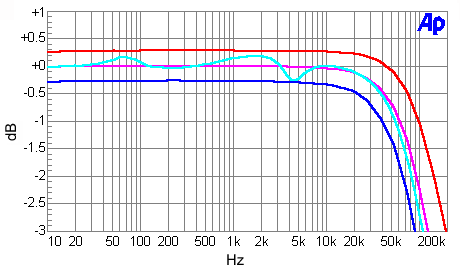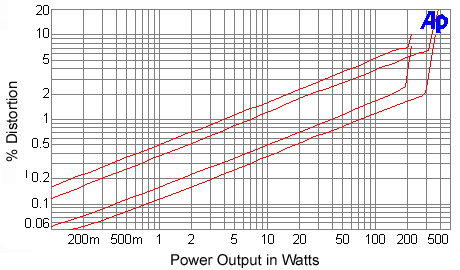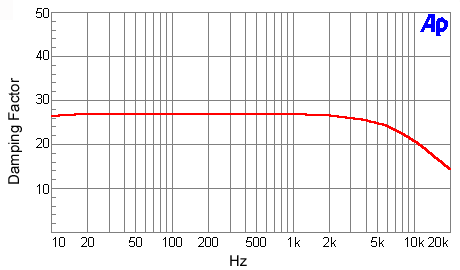December 2003
Monarchy Audio
SE-160 Mono Amplifiers: Measurements
All amplifier measurements are performed
independently by BHK Labs. Please click to learn
more about how we test amplifiers there. All measurement data and graphical
information displayed below are the property of SoundStage! and Schneider
Publishing Inc. Reproduction in any format is not permitted.
- Measurements were made with 120V AC line voltage.
- Power output and distortion plotted with one channel driven
(this is a mono amplifier).
- Gain: 11.3x, 21.1dB.
- Output noise, 8-ohm load, unbalanced input, 1k-ohm input
termination: wideband 0.536mV, -74.5dBW; A weighted 0.185mV, -83.7dBW.
- AC line current draw at idle: 1.47A.
- Output impedance at 50Hz: 0.3 ohms.
- This amplifier inverts polarity.
Power output with 1kHz test signal
- 8-ohm load at 1% THD: 40W
- 8-ohm load at 10% THD: 230W
- 4-ohm load at 1% THD: 72W
- 4-ohm load at 10% THD: 470W
General
The Monarchy Audio SE-160 is an interesting attempt to
duplicate some of the characteristics of a single-ended (SE) tube amplifier in a hybrid
solid-state design. What is very SE-tube-like is the amount and way the distortion rises
with power output, with the second harmonic being dominant. This distortion
characteristic, no doubt, is generated in the vacuum-tube front end of this design. What
is different from most tube SE amplifiers is the wide bandwidth and low out impedance of
the SE-160.
Chart 1 shows the frequency response of the amp with
varying loads. As can be seen in the chart, the high-frequency bandwidth is about 100kHz
and is nicely controlled in shape as a function of loading. In the case of the NHT dummy
load, the variation is about a harmless +/-0.25dB. Chart 2 illustrates how total harmonic
distortion plus noise versus power varies for 1kHz and SMPTE IM test signals and amplifier
output load. As can be seen, attainable power is greater for the 4-ohm load, as is usual
for most power amplifiers. Note the SE-tube-like smooth increase in distortion over the
whole power range. Also note that the distortion is less for a 4-ohm load. Total harmonic
distortion plus noise as a function of frequency at several different power levels is
plotted in Chart 3. Admirable is the low increase in distortion at the higher frequencies.
Damping factor versus frequency is shown in Chart 4. A spectrum of the harmonic distortion
and noise residue is plotted in chart 5 for an 8-ohm load. The AC-line harmonic spectrum
is composed of odd harmonics, and there are some modulation effects of the line frequency
around the second harmonic of the signal test frequency of 1kHz. The signal frequency
harmonic components fall off in a nice manner with the second harmonic most dominant. This
is said to have desirable sonic consequences.
| Chart 1
- Frequency Response of Output Voltage as a Function of Output Loading |

Red line: open circuit
Magenta line: 8-ohm load
Blue line: 4-ohm load
Cyan line: NHT dummy-speaker load
| Chart 2 - Distortion as a Function
of Power Output and Output Loading |

(line up at 5W to determine lines)
Top line: 8-ohm SMPTE IM
Second line: 4-ohm SMPTE IM
Third line: 8-ohm THD+N
Bottom line: 4-ohm THD+N
| Chart 3 - Distortion
as a Function of Power Output and Frequency |

4-ohm output loading
Cyan line: 160W
Blue line: 75W
Magenta line: 10W
Red line: 1W
| Chart 4 - Damping Factor
as a Function of Frequency |

Damping factor = output impedance divided into 8
| Chart 5 - Distortion and
Noise Spectrum |

1kHz signal at 10W into an 8-ohm load
|
![[SoundStage!]](../titles/sslogo3.gif) Home Audio
Home Audio ![[SoundStage!]](../titles/sslogo3.gif) All Contents
All Contents



